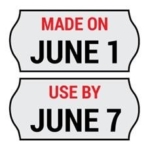Date Labeling of Time/Temperature Control for Safety (TCS) Food
Updated on: June 3, 2020
Using date labeling lets us know when food should be discarded because it is no longer safe to eat. Expiration dates for TCS food are designed to control the growth of Listeria monocytogenes, bacteria that grow under refrigeration.
Refrigerated, ready-to-eat, TCS food must be discarded within seven days. The date a product is opened or prepared counts as day one and it can be kept for an additional six days. For example, food prepared or opened on April 1 must be used by April 7 or discarded.
Making a food with multiple ingredients will require using the date of the oldest ingredient. For example, burgers cooked and cooled on June 1 are then used to make chili on June 3; the final use by date will still be June 7, based on the burger cooked date.
There are some exemptions to the seven-day requirement, see the Regulations for more details.
Facilities can use any method (e.g. sticker, date mark, dots) to show when food was prepared or must be discarded. Staff should be trained to consistently use the same system. 
TCS food is good for seven days in the refrigerator, however, the facility may freeze the food to extend the shelf life. Upon freezing, time “stops” and the shelf life of seven days resumes upon thawing.
Example 1: Lasagna made April 1 is held until April 3 in the refrigerator (three days). On April 3, the food is frozen. Upon thawing, label the lasagna for an additional four days under refrigeration.
Example 2: Lasagna made April 1 is immediately cooled and frozen. Upon thawing, label the lasagna for 6 days under refrigeration.
Once food is thawed in the refrigerator, it can be refrozen. A food that is thawed and cooked can be refrozen if the seven-day shelf life is not exceeded.
Updated on: June 3, 2020